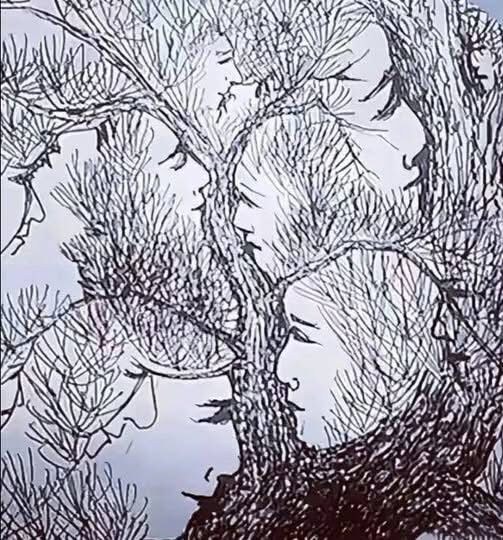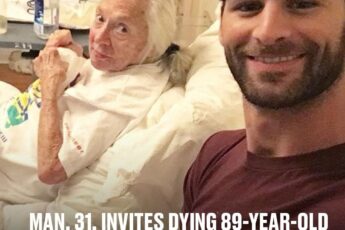Only 0.1% of people can find all the faces within 30 seconds. It sounds almost unbelievable, but the challenge taps into something that fascinates both scientists and ordinary people alike—the mysterious way our brains interpret the world around us. Have you ever paused for a moment, gazed at a tree trunk, and suddenly seen the faint outline of eyes, a nose, and a mouth staring back at you from the bark? Or maybe you’ve looked up at the clouds on a summer afternoon and noticed one that looked uncannily like a person’s profile, a dog’s head, or even a dragon floating across the sky. This fascinating and very human phenomenon is known as pareidolia, our brain’s tendency to detect familiar patterns, especially human faces, in random textures and shapes.
At first, it might seem like just a fun quirk of imagination, but pareidolia is deeply rooted in how our brains are wired. Humans are naturally programmed to be on the lookout for faces. From the moment we’re born, we begin to recognize facial features, and this ability is critical for survival, communication, and connection. That’s why even the vaguest suggestion of two eyes and a mouth—a pattern of three dots arranged just right—immediately registers as a “face” in our minds. We can’t help it; it’s part of who we are. Scientists believe this instinct may have developed as an evolutionary advantage. In ancient times, spotting a face quickly in the shadows could mean the difference between recognizing a friend or identifying a potential threat. Today, it might not be about life or death, but the brain still hasn’t let go of the habit.
Consider how often pareidolia sneaks into your everyday life. People notice faces in the front grills of cars, where headlights resemble eyes and the curved lines of the hood form a mouth. A slice of toast with a scorch mark can suddenly look like a smiling figure, leading some people to believe they’ve encountered a miracle. Rocks on a hiking trail, with grooves and shadows in just the right places, can appear like ancient statues carved by nature. Even the moon, when you look at it long enough, transforms into the “man in the moon” with a calm face gazing down at Earth. These illusions aren’t just coincidence—they are proof that our brains crave patterns, often finding them even where they don’t exist.
Psychologists studying pareidolia explain that the brain doesn’t like randomness. When we look at a complicated or messy texture, whether it’s a wood grain, cloud formation, or even a pile of laundry, our brain rushes to make sense of it. Faces, being one of the most important visual cues in our social lives, become the default pattern we detect. It’s like our minds are constantly whispering: “There must be something familiar here—oh, look, it’s a face!” That’s why so many optical illusions and puzzles play on this quirk. When someone says only 0.1% of people can find all the faces in an image within 30 seconds, it’s not just about sharp eyesight; it’s about how quickly the brain can connect the dots and recognize subtle hints of faces hidden within the chaos.
But pareidolia isn’t only about faces. Our minds see patterns in many forms. Some people notice animals in clouds, mythical creatures in rock formations, or even letters and numbers appearing in grains of sand. Still, faces remain the most powerful example, and for good reason. We are social beings, constantly relying on faces for communication. The lift of an eyebrow, the curve of a smile, or the narrowing of eyes conveys entire worlds of meaning without a single word being spoken. No wonder our brains are so eager to detect a face, even in lifeless objects.
This tendency also explains why many people feel emotional reactions to these “found faces.” Spotting a cheerful expression in the steam swirling from a coffee cup or in the pattern of bathroom tiles can make you smile, even if you know it’s not real. On the flip side, noticing a sinister or angry “face” in a dark corner can make you uneasy. The object itself is harmless, but the feeling lingers, a reminder of how powerful our perceptions are. It’s no surprise that many ghost stories and supernatural sightings are tied to pareidolia. Shadows and dim lighting can create shapes that resemble figures, leading our imagination to do the rest.
Artists and creators have long used this natural quirk to their advantage. Think of Salvador Dalí’s surrealist paintings, where landscapes and objects morph into faces or figures when you look closely. Or consider how Halloween decorations often rely on exaggerated facial patterns carved into pumpkins or hidden in costumes to trigger a reaction. Even modern designers sometimes play with pareidolia, giving objects like appliances or furniture subtle “expressions” to make them feel more relatable or friendly.
Interestingly, pareidolia isn’t just a curiosity—it can have practical benefits. Some researchers suggest that training the brain to notice hidden patterns could sharpen attention to detail and improve cognitive flexibility. That might explain why puzzles and optical illusions are not only entertaining but also stimulating for the brain. Spotting those hidden faces quickly requires focus, patience, and creativity. For the few who manage it within seconds, it feels like a small triumph, as though they’ve momentarily tapped into a deeper level of perception.
But perhaps what makes pareidolia truly special is how universal it is. Children giggle at seeing “smiley faces” in pancakes, adults point out animal-shaped clouds to each other on lazy afternoons, and even the most serious scientist can’t help but smile when a microscope slide reveals a shape that looks oddly familiar. It’s a reminder that no matter how rational or logical we try to be, our minds still carry a spark of wonder.
So, the next time you come across an optical illusion challenge claiming that only 0.1% of people can find all the faces in record time, give it a try. Even if you don’t find them all, you’ll be exercising that quirky, imaginative side of your brain that loves to play detective. And beyond the puzzle itself, take a moment to notice how often pareidolia appears in your daily life. Maybe in the morning, as you pour milk into your coffee, you’ll see a pattern that looks like a grin. Or perhaps later, as you walk home, the cracks in the sidewalk will form something that resembles a winking face.
In a world often dominated by schedules, tasks, and seriousness, these little discoveries can bring unexpected joy. Pareidolia is more than just a brain glitch; it’s a reminder that humans are wired not only to survive but to find meaning, connection, and even humor in the simplest corners of life. Whether it’s a face in the bark of a tree, an expression in the clouds, or a hidden puzzle that only a few can solve, each sighting invites us to pause, smile, and marvel at the playful tricks our minds love to play.






